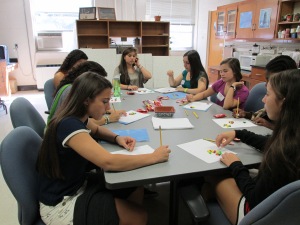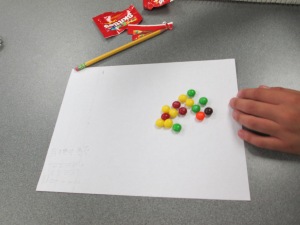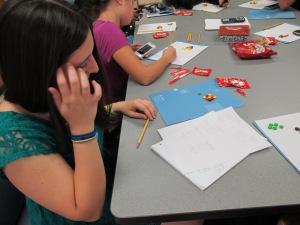This past week I attend the annual “Evolution conference,” which is a joint meeting of The Society for the Study of Evolution, the American Society of Naturalists and the Society of Systematic Biologists. Evolution 2013 was held in Snowbird, Utah, a ski resort and conference center that feels isolated despite being right up the road from Salt Lake City. I also attended a special workshop for undergraduate educators (there was also a workshop for K-12 educators). This workshop was so popular that they expanded the attendance from thirty participants to fifty. The focus on education was just one trend I noticed at this year’s meeting, where I saw many changes from when I first started attending meetings fifteen years ago.

View of Salt Lake valley from 11,000 foot summit of Hidden Peak, reached via Snowbird tram. (Photo credit: Wikipedia)
For those of you that haven’t attended one of these meetings, here’s a brief run-down of how it goes: during the day scientists present their research in twelve-minute talks. These are arranged in fifteen-minute blocks so that people have time to take questions and go from one room to another: there are up to ten of these sessions going on at the same time, hence they are called “concurrent sessions.” This is analogous to what people used to call “reading a paper” or “giving a paper,” but we call it “giving a talk” or “doing a talk.” In the evening there’s a long talk by a society president or someone getting a major award, and then people gather for a social event, usually a poster session. A poster session is when researchers present their data literally on a poster tacked to a wall, and stand beside it while people drinking wine and munching hors d’oeuvres walk by and receive five-minute mini-talks on the data in the poster. I presented a poster on my sexual selection research.
Interesting Talks and Posters
I found many of the talks and posters at the meeting very interesting. Going to scientific meetings is where we see the real communication in the scientific community. At a symposium entitled “Evolution out of bounds,” several speakers examined the promise and failings of evolution when applied to human problems.

David Sloan Wilson
David Sloan Wilson presented his collaborations with economists and the results of a project to help academically failing high-school students using the principles of evolution of cooperation. Joan Roughgarden presented an organismically based model of the evolution of physical intimacy. She had previously announced her talk as “Evolution of human sexuality,” but opened by apologizing and saying we can’t discuss the evolution of something we haven’t described completely. Roughgarden put forth the radical idea that we could consider immediate organismal causes for certain behaviors (i.e. something she called “fun”) before considering evolutionary consequences.
In regular paper sessions Michael Sheehan of Arizona University presented evidence that there is selection for diversity of human faces to aid in individual recognition. Corlett Wood of University of Virginia showed what might happen when the environment induces a correlation between response to selection and heritability. And one of many presentations on archaic hominins showed that the epigenetic changes between modern humans and Neanderthals lead to broadening of knees and other Neanderthal features. A packed room listened to Michael Turelli admit (in his own special way) that he had completely screwed up the statistical analyses in a talk that he had already been giving as an invited speaker — and submitted for publication! Opposite my own poster at the Sunday night poster session was one of a few studies of the development of feathers in pigeons and doves: the authors narrowed down the cause of curly feathers in certain dove breeds to a single biochemical factor, due to a single nucleotide change.
I missed a talk that had people talking by Adi Livnat of Virginia Tech. Based on one of my colleagues’ descriptions, Livnat is dissatisfied with adaptive explanations of the origin of new genes. Whenever anyone questions the gospel of adaptationism, people definitely start talking. Livnat was going further than questioning however, so a lot of people were talking. I actually overheard someone saying “Did you hear that? Wow…”
A new form of neofunctionalization
The talk that excited me most was the last talk of the meeting, about two hours before the banquet. I’ll admit that I was only there because I had dinner with the speaker after striking up a random conversation in the hotel lobby. Myself, Ashley Byun of Fairfield University and her former student and colleague Russ Meister of UConn were looking for a place to eat dinner the night before the education workshop. At the time of Ashley’s talk there were fewer than twelve people in the room, backing up our concensus from dinner that most people would be off showering for the banquet or hiking. Despite all this, for very important reasons I liked the last talk of the meeting the best.

Mutation by gene duplication (Photo credit: Ethan Hein)
Dr. Byun presented a new idea for the neofunctionalization of duplicated genes: protein subcellular relocalization. For many reasons in eukaryotic organisms (for example, animals, plants, fungi) genes can become duplicated so that for a while there are two copies of a gene doing the same thing. Theory suggests that while two copies is better than one for some genes, as long as they produce the same product, they are relatively redundant, and one of the copies may acquire mutations that cripple its function over evolutionary time. It may then degrade into junk (“die”). However, the theory goes, the duplicate gene may acquire a new function. The most common explanation (i.e. the one we tell students in basic science courses) is that the duplicate would mutate into a gene producing a new protein.
Duplicate genes acquiring new functions by producing new proteins is incredibly unlikely. If we assume that crippling mutations are more common than “beneficial” mutations (that enhance the function of a protein), then there’s probably no way getting a new function would happen before the duplicate gene turns into biochemical sewage. Despite this problem, we commonly teach undergrads that this exact process is what made the Cambrian Explosion possible.
A nifty function of eukaryotic cells is how they package proteins and tell them where to go in the cell (or out of the cell). When proteins leave the site of protein synthesis, they are tagged with a sequence of amino acids (the “signal peptide”) that tells them where to go in the cell, e.g. to mitochondria, endoplasmic reticulum or a chloroplast. Normally the signal peptide is just a signal and when the gene reaches its destination, it is cleaved off and does not do anything else. If this sequence mutates, the protein product could get sent to a new part of the cell, where Byun points out it could perform a new function.

Apoptosis Network (Photo credit: sjcockell)
Now I don’t want to get too excited, but this is the first positive hypothesis I’ve seen for neofunctionalization, which could explain two of the most puzzling (for me) features of eukaryotes: the complexity of body plans and the dazzling, bewildering, uber-complicatedness of eukaryotic epistatic gene networks. As I mentioned above, we commonly teach that gene duplication, especially in homeobox genes, was the key to the diversification of animal body plans, but we don’t point out the exceedingly unlikely events that would make gene duplication and neofunctionalization actually work. Over the past year I taught cellular and developmental biology, and then genetics and molecular biology. As one example of eukaryotic complexity I learned that between the already complicated steps of apoptosis in Caenorhabditis elegans and the same process in Homo sapiens there’s about a gazillion things making it more complicated. An answer for this based on adaptation is that humans are more complex than worms, and therefore need more complex signaling pathways. This hypothesis ignores the fact that humans didn’t exist before the pathway got more complex, or why such complex organisms exist in the first place. We often assume it’s adaptation. An answer that I find more likely is that these biochemical networks are built by patching together steps that are slight modifications of completely unrelated functions. Eukaryotic cells are like Rube Goldberg machines built by a team of six-year-olds all working on only one piece at the same time. At the end they all get together and link things up.
Dr. Byun’s talk showed compelling evidence that duplicated genes that acquire mutations in the signal peptide are more likely to stay alive over evolutionary time instead of degrading into junk. In other words, acquiring a new cellular destination appears to keep duplicate genes from acquiring mutations that would cripple their biochemical function. Let’s be clear: she did not show that these mutations actually do send duplicate gene products to new organelles. However, she looked over a huge diversity of taxa and a huge number of genes, and almost all the data was significantly in favor her hypothesis.
I found Byun’s talk compelling for another reason: her speaking style. First of all she went slowly and explained her hypothesis clearly enough that a guy with minimal experience with cell biology could understand it. Secondly, she prepared the audience in two ways: by explaining which numerical values would support her hypothesis, and by showing snippets of data before blowing away the audience with a huge array of results. She walked slowly through what a hazard ratio is, then explained “If this ratio is greater than 1…less than 1…equal to one…then…” Then she showed a slide that had results for about five genes (as I recall). On this she explained a color code that showed supportive, not supportive, and inconclusive results, and walked the audience through why each cell in the table was coded the way it was. Then she flipped the slide and showed a huge table with many species and it was clear from the predominance of green color that most of the results supported her hypothesis. She did all that without saying “This is really complicated so I’m going to walk you through it…” (For non-initiates, that is a phrase that some speakers use, but many have advised me not to, because it may sound condescending to the audience).
Trends
I noticed several trends developing at this meeting:
- Focus on education: not only did I attend a workshop for educators, but the meeting was interspersed with papers and discussions of how to better teach evolution, not just of how to convince basic science students against creationism
- Experimental evolution: Rich Lenski and his academic offspring have shown that experimental evolution directly tests the hypotheses of evolutionary theory. I saw many talks using artificial selection, and not just in microbes.
- Applying evolution to non-biological systems: two symposia were devoted to applying evolutionary biology to problems outside the typical realm of discourse. This used to be unpopular, but is now gaining momentum.
- Multilevel science: some people might derisively call it reductionism, but what I saw was a lot of researchers testing behavioral, anatomical and systematic hypotheses, and then going to the very lowest levels of biological organization to find data. Now that gene sequencing is becoming less expensive, technology is enabling scientists to find support for their predictions at all levels of biological organization, from genes up to global geographic data, quite often in the same study (e.g. Michael Sheehan’s work on faces).
The importance of scientific meetings
Attending the Evolution 2013 meeting reinforced to me that scientific meetings are where the most important scientific communication takes place. I find this quite important, especially considering all the discussion of publishing lately. If we consider that what you hear at meetings is mostly new, very little of it published, and that scientists at meetings are face-to-face where they can discuss ideas spontaneously, then publication appears in its proper place: as a public record, a way of preserving research for posterity, not as the end-all goal of scientific exploration. Much of what is presented at meetings is preliminary, some of it is just new ideas people have. Very little of it is so polished that it isn’t open to amendment or suggestion. And most scientists are open to new ideas at the stage where they are: once a paper is published, the work has been done for almost a year, sometimes five years. At that point, all that is left is to deposit something for archaeologists to dig up. In other words, going to meetings like this reminds me that publications are not science, nor are they even the best way of communicating science. The best way to communicate science, or anything, is face-to-face.








 A recent study
A recent study





